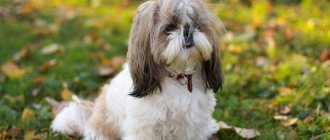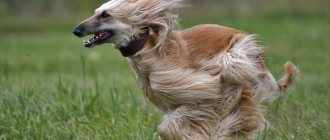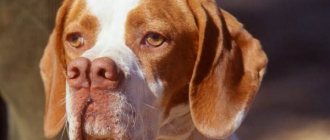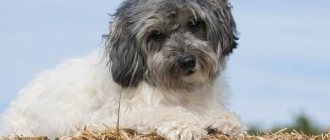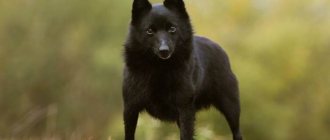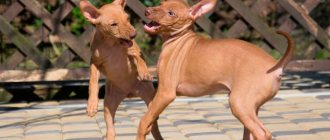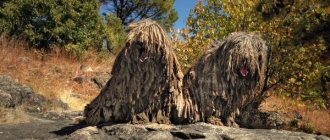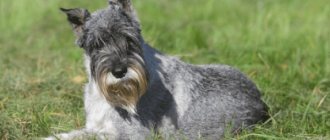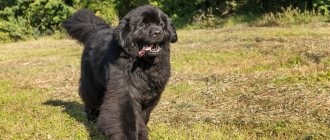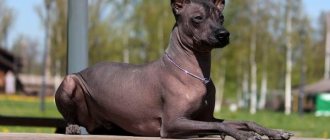“Svet Posada” is a private kennel of Maremmo-Abruzzese Shepherd Dogs in the RKF/FCI system (certificate No. 17777). All litters of puppies are born from purebred dogs in compliance with the rules of the RKF Breeding Regulations.
We strive to produce healthy dogs that meet the standard of the Maremmo-Abruzzese Sheepdog (Maremma) breed. When selecting a pair, we study the pedigree, evaluate the health, appearance, temperament and character of the partner. Our dogs have RKF/FCI documents. There are no Maremmo-Abruzzese Shepherd puppies without a pedigree or unplanned puppies in our kennel. Litters of puppies are born in compliance with all the rules of the RKF Breeding Regulations.
We are ready to discuss all your questions at any time.
Description and features
The first standard accurately describing the breed's condition was drawn up in 1924. In 1958, a standard was agreed upon and printed, combining two versions of the dog: the Maremese and the Abruzzese. The latest edition of the standard was released by the FCI association in 2015. It describes in detail what an Italian Shepherd should ideally be like.
- General description. Cattle, herding and guard dogs are quite large in size. The animal is hardy. It tolerates work well in mountainous areas and on the plain.
- Basic dimensions. The body is elongated. The length of the body is 20% greater than the height at the withers. The head is 2.5 times shorter than the height at the withers. The transverse size of the body is half the height at the withers.
- Head. Large, flattened, resembles a bear's head.
- Scull. Wide with an inconspicuous sagittal ridge on the back of the head.
- Stop. Smooth, low forehead, the forehead meets the muzzle at an obtuse angle.
- Nose. Noticeable, black, large, but does not violate the general features. Constantly wet. The nostrils are fully open.
- Muzzle. Wide at the base and narrowed towards the tip of the nose. Occupies approximately 1/2 the length of the entire head. The transverse size of the muzzle, measured at the level of the corners of the lips, is equal to half the length of the muzzle.
- Lips. Dry, small, covering the upper and lower teeth and gums. Lip color is black.
- Eyes. Chestnut or brown.
- Teeth. The set is complete. The bite is correct, scissor-shaped.
- Neck. Muscular. 20% shorter than the length of the head. Dense fur growing on the neck forms a collar.
- Torso. The Maremma is a dog with a somewhat elongated body. The linear size of the body refers to the height from the floor to the withers, as 5 to 4.
- Limbs. Straight, set vertically when viewed from the side and front.
- The paws are supported by 4 toes, which are pressed against each other. The finger pads are distinct. The entire surface of the paws, except for the pads, is covered with short, thick fur. The color of the claws is black, dark brown is possible.
- Tail. Well pubescent. In a calm dog it is lowered to the hock joint and below. An excited dog raises its tail to the dorsal line of the back.
- Movement. The dog moves in two ways: at a walk or at a vigorous gallop.
- Wool cover. The guard hair is mostly straight, the undercoat is thick, especially in winter. Wavy strands are possible. The fur on the head, ears, and ventral part is shorter than on the rest of the body. The molt is not extended and occurs once a year.
- Color. Plain white. There may be slight hints of yellow, cream and ivory.
- Dimensions. The height of males is from 65 to 76 cm, females are more compact: from 60 to 67 cm (at the withers). The weight of males is from 36 to 45 kg, females are 5 kg lighter.
The professional specialization of Italian Shepherds has made their muscles strong and strengthened their bones. This is confirmed by photos of the Abruzzese maremma . Obviously, these shepherds are not very fast - they will not be able to catch up with a deer or a hare. But they can easily force an attacker, be it a wolf or a man, to abandon his intentions.
Cynologists explain the white color of dog fur by shepherding work. The shepherd sees white dogs from afar, in the fog and twilight. Can distinguish them from attacking gray predators. In addition, white wool reduces exposure to bright high-altitude sun.
Dogs most often work in a group. Their task does not include direct combat with wolves. By barking and collective action they must drive away attackers, be they wolves, feral dogs or bears. In the old days, the equipment of dogs included a collar with spikes - a roccalo. Animal ears have been and are still cropped in countries where this operation is permitted.
Distinctive features
Maremmas are recognizable by their distinctive features:
- The head is large, large, flat, similar to a bear.
- The forehead is low.
- The ears are large, hanging to the level of the cheekbones, set wide, pointed at the ends; cupping is rarely practiced.
- The stop is clearly pronounced, obtuse.
- The muzzle is narrow, bear-like; The nose is black.
- The eyes are dark, black, almond-shaped; eyelids black.
- The lips are dense and small.
- The teeth are strong and powerful; bite .
- Black leather
- The body is powerful, the muscles are distinct.
- The back is wide, muscular, straight.
- The chest is strong, developed, wide.
- The thighs are strong, with obvious muscles, and sculpted.
- Limbs straight, strong, elegant; The paws are massive and round in shape.
- The color is white, minor light tones are acceptable (fawn, red, beige).
- The hair on the head is of medium length, no more than 5 cm; The coat of the body is thick, with dense undercoat, 9-10 cm.
- The tail is covered with thick hair and is set low; When moving or having a strong emotional reaction, it rises slightly.
Kinds
Until the middle of the 20th century, the breed was divided into 2 types. was considered a separate breed . An independent breed was the herding dog from Abruzzo. Once upon a time this was justified. Maremmo dogs herded sheep on the plains and swamps. Another variety (from Abruzzo) spent all its time in the mountains. Plain animals were somewhat different from mountain animals.
In 1860, Italy was unified. Borders have disappeared. The differences between the dogs began to level out. In 1958, the unity of the breed was formally consolidated, and shepherd dogs began to be described by a single standard. In our time, past differences were suddenly remembered in Abruzzo. Dog breeders from this region want to distinguish their dogs into a separate breed - the Mastiff from Abruzzo.
Dog handlers from other provinces do not lag behind the residents of Abruzzo. There are proposals to divide the breed into subtypes, based on small differences and their places of origin. After the implementation of such ideas, shepherd dogs may appear from Apullio, Pescocostanzo, Maiello and so on.
How to choose a puppy
- If you do not plan to raise a working shepherd dog from a Maremma to guard livestock and property, look for breeders who breed show and domestic lines of the breed. Their charges are more focused on human contact and less suspicious of others.
- A good Maremma puppy is a brave puppy! If at the entrance to the nursery you are barked by a four-legged shaggy ball, you can rest assured that in the future he will grow into a brutal and stern watchman.
- It is not advisable to take a pair of same-sex puppies: both in work and in everyday life, Maremma males and females get along better with representatives of the opposite sex.
- Assess the living conditions of the puppies in the kennel: dogs should not be locked up and afraid of people. An unpleasant smell in the room where animals live is also not the best characterization of the breeder.
- It will be a great advantage if sires have their litter tested for genetic joint dysplasia.
- Always check the age of the manufacturers. Keep in mind that Maremma Abruzzese Shepherd bitches are allowed for breeding from the age of 18 months and finish their breeding “career” by the age of 8 years.
- Find out from the seller what the litter of puppies is for the year. Ideally, a maremma breeds once every 12 months. In some cases, two litters per year are allowed - FCI no longer registers more than that.
History of the breed
In fragments of the treatise De Agri Cultura, dating back to the 2nd century BC, the Roman official Marcus Porcius Cato describes three types of dogs:
- herding dogs (canis pastoralis) - white, shaggy, large animals;
- Molossians (canis epiroticus) are smooth-haired, dark, massive dogs;
- Spartan dogs (canis laconicus) are fast-footed, brown, smooth-haired hunting dogs.
Probably the description of canis pastoralis by Marcus Cato is the first mention of the ancestors of modern Italian cattle dogs. The antiquity of the origin of the breed is confirmed by the work of the Roman historian Junius Moderatus Columella “De Re Rustica”, dating back to the 1st century BC.
In his opus, he dwells on the importance of white coat color for herding dogs. It is this color that makes it possible for a shepherd in the dark to distinguish a dog from a wolf and direct his weapon against the beast without injuring the dog.
Italian Maremma Shepherds are constantly described, painted, immortalized in frescoes, and laid out with colored glass in mosaic paintings. In works of art, the slowness, tranquility and piety of rural life were symbolized by humble sheep. They were guarded by strong maremmas. To be convincing, the dogs wore collars with spikes.
In 1731, a detailed description of the Maremma appeared. The work “Pastoral Law” was published, in which lawyer Stefano Di Stefano provided data on herding dogs. In addition to describing the physical parameters, it talked about the nature of the maremma . His independence, combined with devotion, was emphasized.
The author assured that the dog is not bloodthirsty, but is capable of tearing anyone apart at the command of the owner. The Maremma performs its difficult and dangerous work as a shepherd on a modest diet. It consisted of bread or barley flour mixed with whey obtained during the cheese making process.
The method of grazing sheep played an important role in the formation of the breed. In summer, flocks of sheep fed on the mountain pastures of Abruzzo. By autumn it was getting colder, the herds were driven to the flat marshy area of the Maremma. Dogs walked along with the herds. They mixed with local animals. The differences between lowland and mountain dogs disappeared.
In Genoa, in 1922, the first club of Italian herding dogs was created. It took two years to compile and edit the breed standard, which calls it the Maremma Sheepdog and mentions that it can also be called the Abruzzi. For a long time after this, dog handlers could not decide on the name of the breed.
Character
The standard describes the character of the maremma something like this. The Maremma breed is created for herding work. She is involved in driving, herding and protecting the sheep flock. Treats animals and shepherds as his family. When working with animals, she makes decisions about further actions. He eagerly follows the orders of his masters.
When attacking sheep she controls, she does not seek to destroy the beast. It considers its task completed when the predator is driven away to a certain distance. This way of working increases the efficiency of the shepherd’s actions: the Maremma never leaves the herd for long.
The Maremma treats strangers without aggression, but is wary, and welcomes members of the owner’s family with joy. She takes care of the children and calmly accepts their liberties. The character of the dog allows, in addition to peasant work with animals, to be a companion, rescuer and even a guide.
Nutrition
For most of their history, dogs lived alongside shepherds and sheep. Their diet was peasant. That is, modest and not very diverse, but absolutely natural. Written sources confirm that the dogs were fed bread and flour mixed with whey. In addition, the diet included everything that the shepherds ate, or rather, what was left from the peasants’ meals.
In our time, food asceticism has faded into the background. Dogs receive food prepared especially for them. The exact determination of the amount of food and its composition depends on the animal’s age, activity, living conditions, and so on. The total volume of food lies within 2-7% of the animal’s weight.
The menu should contain animal proteins, plant and dairy components. Approximately 35% comes from meat products and offal. Another 25% are vegetables, stewed or raw. The remaining 40% is boiled cereals combined with dairy products.
Reproduction and lifespan
Maremma Sheepdogs nowadays are divided into two categories. The first, as befits a shepherd dog, spends its entire life among sheep. Leads a semi-free existence. Since the sheep are guarded not by one dog, but by a whole company, Maremma puppies are born with minimal human intervention.
When living under the constant care of a person, reproduction problems must be resolved by the owner. First of all, when a puppy appears in the house, you need to decide: to provide the animal and the owner with a quiet life or to preserve their reproductive function. Castration or sterilization is most often the right solution, relieving many problems.
A fully functioning dog becomes ready to reproduce at around 1 year of age. But it’s worth waiting a while: breeding bitches starting from the second heat. That is, when she is at least 1.5 years old. For male dogs, 1.5 years of age is also a good time for paternal debut.
Breeders are well acquainted with organizing and conducting meetings for dogs to solve reproductive problems. Matings of purebred animals are planned for a long time in advance. Inexperienced dog owners should seek comprehensive advice from the club. Properly resolved breeding issues will keep the dog healthy for the entire 11 years that a Maremma lives on average.
Which owner is it suitable for?
This dog is perfect for an active person who monitors his physical fitness and likes to go for long walks or jogs in the mornings and evenings. She will happily accompany her owner, protecting him from various troubles and at the same time carefully studying the environment.
It is better not to get this breed of dog for people who have health problems, because in the event of any conflict situation on the street with another member of the canine family or a person, it will be quite difficult for a sick and weak person to contain the ardor of his dog and not allow him to enter into a fight.
The owner must have pronounced leadership qualities and be distinguished by perseverance and self-confidence, so that the dog recognizes him, if not as its leader, then at least as its equal. A loud, well-placed commanding voice will only help strengthen your authority with the dog.
Care and maintenance
In early youth, with legal permission, Maremmas have their ears cropped. Otherwise, keeping Italian Shepherds is not difficult. Especially if the dogs do not live in a city apartment, but in a private house with a large adjacent plot. Maximum movement is the main thing that an owner should provide to his dog.
The biggest problem is grooming. Like all medium- and long-haired dogs, the Maremma needs regular brushing. What makes the wool better and the relationship between man and animal more trusting.
For high-born dogs, part of whose life is spent participating in competitions and championship rings, grooming becomes more complicated. Not only brushes and combs are used, a few days before the ring the dog is washed with special shampoos, and nails are trimmed.
Application
The Maremmo is a purely working breed that can be “hired” to guard your property without much thought.
Ideal skills, as in the case of Swiss , Eastern European and Australian Shepherds , have been practiced over centuries and are fixed at the genetic level.
It must be said that the breed is so good at what it does that they didn’t even want to subject it to any selection in order to improve anything.
Choosing a puppy should begin with examining its mother. If a dog looks very thin and unhealthy, it makes you wonder if it was able to pass on good physical characteristics to its offspring.
Price
Maremma was recently a rare breed in our country. Now, thanks to its qualities, it has become quite widespread. Prices for puppies of this breed remain high. Breeders and nurseries ask about 50,000 rubles for an animal. This is the average price of maremma .
Interesting Facts
There are several facts associated with the Maremmo-Abruzzese dog that are worthy of attention. One of them is sad.
- Having crossed the threshold of approximately 11 years, considering that the life limit has come, dogs stop eating, then stop drinking. They end up dying. Being healthy, animals pass away. Owners and veterinarians are having trouble bringing Maremma Sheepdogs out of voluntary decline.
- The first known depiction of a white shepherd dog dates back to the Middle Ages. In the city of Amatrice, in the Church of St. Francis, a 14th-century fresco depicts a white dog in a spiked collar guarding sheep. The dog in the mural looks the same as the modern maremma in the photo .
- In the 1930s, the British exported several herding dogs from Italy. At this time, there were disputes between animal connoisseurs about which province made a decisive contribution to the formation of the breed. The British were not imbued with the small-town concerns of the Italian dog handlers and called the dog Maremma. Later, the breed received a longer and more precise name: Maremmo-Abruzzese Shepherd Dog.
- In the last century, in the 70s, sheep farmers in the United States had a problem: meadow wolves (coyotes) began to cause noticeable damage to sheep herds. Environmental laws limited how predators could be controlled. Adequate countermeasures were required. They were found in the form of herding dogs.
- 5 breeds were brought to the States. In competitive work, Maremmas have proven that they are the best shepherds. In sheep herds guarded by Italian Shepherds, losses were minimal or non-existent.
- In 2006, an interesting project began in Australia. The population of one of the species of aboriginal penguins has approached the numerical limit beyond which an irreversible process of extinction begins.
- The government has recruited Maremma herding dogs to protect birds from foxes and other small predators. They were considered the reason for the decline in bird numbers. The experiment was successful. Now maremmas guard not only sheep, but also penguins.
Dog training
To train most breeds, it is acceptable to seek the help of a specialist. However, in the case of maremma, it is better to minimize outside interference.
It is unacceptable to punish a dog when training
The fact is that the breed reacts not only to a voice command, but also to the appearance of the person giving it. Being an excellent analyst, the shepherd evaluates the authority, confidence and behavior of the commander. Having become accustomed to one “leader,” she will obey him, but will be hostile to a sudden return home and a change of leader.
To avoid mistakes in training, it is recommended to conduct training under the supervision of an instructor. It is enough to carry out such exercises 1-2 times a week. Basic training without the participation of a specialist is carried out twice daily. The duration of the workout should not exceed 15 minutes. By repeating the same trick ten times, the dog will associate training with coercion and resist training. Lessons should be varied and active.
The treat is used for both small puppies and adult pets. At the initial stage, the dog receives a piece of cheese or beef every time after a correctly performed trick. Next, you can treat the puppy every other time, replacing the prize with stroking and sincere praise.
The time of one workout should not exceed 15 minutes
Table 1. Training rules
| Trainer's action | Description |
| Pronunciation of commands | Clear and loud, confident voice. The wording of the command cannot be changed. If necessary, you can only vary the intonation. |
| Promotion | In addition to tasty treats, the dog should receive emotions and approval. Ideally, when praised, she wags her tail and positively perceives the owner’s reaction. |
| Categorical | You cannot move on to the next command if the previous one is not completed. It is important that the pet responds adequately to every order of the owner. |
| Completing a command | The completion of a trick is always clearly indicated. As a transition, you can use another order or permission to go to games (“walk”). |

